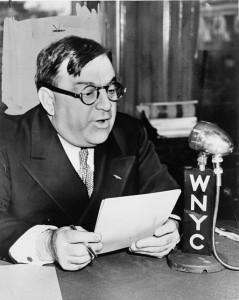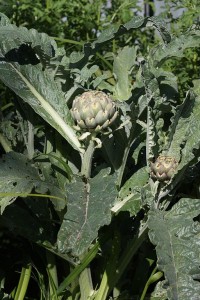ANNALS OF FOOD HISTORY
Near dawn on a frigid morning in December, the coldest day in the year, New York City Mayor Fiorello La Guardia climbed up the back of a flat-top truck at the Bronx Terminal Market and, unrolling a large scroll, proclaimed a ban on the sale of artichokes. On December 21, 1935, the Mayor’s arrival had been announced by the roar of police bugles. As vendors and other spectators crowded around him, the “Little Flower,” as he was known, declared that a “serious and threatening” emergency endangered the artichoke business. The vegetable with a storied past (but still foreign to most Americans) had precipitated a crisis in the nation’s largest city. On the next day, the New York Herald Tribune derided the Mayor for his “protection of the virtue of artichokes. . . . It is impossible not to conclude the world today is a bit mad,” the paper opined.
The Mafia had seized control of the traffic in artichokes, grown largely by Italian farmers in coastal northern California. Ciro “Whitey” Terranova, a mob chieftain dubbed the “Artichoke King,” had built a monopoly by threatening and wreaking violence on all its purveyors. By frightening away all other wholesalers, the East Harlem gangster and his cohorts reaped a huge profit. Typically, the mobsters bought artichokes at $6.00 a crate and resold them at a 30-40% profit.
La Guardia had explicitly prohibited the sale of baby artichokes, favorites of the city’s large Italian community. The ethnics were particularly fond of these small, choke-less vegetables, which sprout at the bottom of the same plant that produces the larger, more familiar artichokes. The steep prices imposed by the Mafia’s monopoly injured the Italians more than any other shoppers. The artichoke vendors who retailed the product were also victimized. Cleaning up the city’s street markets had been a crucial objective of the Mayor. He was appalled by the crime and unsanitary conditions that were rife in New York’s pushcart districts. The creation of a modern wholesale market, La Guardia felt, would be a cure for these ills. “I found you pushcart peddlers. I have made you merchants,” La Guardia told vendors when he dedicated the revitalized Bronx Terminal Market. That racketeers were corrupting one of his proudest achievements angered the city leader. In his speech that December day, La Guardia laid down the gauntlet: “I want it clearly understood [that] no thugs, racketeers or punks are going to be allowed to intimidate you as long as I am mayor of the City of New York.”
The mobsters also attacked the artichoke supply chain itself. Gangs took the fight to the artichoke fields of northern California. The “Artichoke Wars,” which erupted in 1930, still evoke chilling memories among the region’s Italians. The mob offered growers a non-negotiable price. “We either accept the price, or get our skulls cracked,” as one farmer told it.
To limit supply and thus keep prices high, thugs terrorized the artichoke fields. As California historians Michael Svanevik and Shirley Burget tell the story, marauding gangsters wielding machetes invaded thousands of acres in northern California during the fall of 1930. Thugs stripped the buds off plants and hijacked trucks carrying boxes of the product. To protect farmers from the nightly raids, the San Mateo County sheriff dispatched “posses” carrying sawed off shotguns to patrol the back roads and guard the ranches. Clashes between the two sides broke out. In one incident on November 25, 1931, two guards fought a gun battle with interlopers trying to steal crates of artichokes. Despite the government’s efforts, the mob achieved its objective. The artichoke farmers were frightened into submission.
Ultimately, the racketeers surrendered, and La Guardia broke up the artichoke monopoly. Although his prohibition lasted only a week, the mayor had sent a stern message. The artichoke market was opened to legitimate wholesalers. Prices were reduced and sales increased. Recipes using the vegetable appeared in newspapers. La Guardia’s triumph over the mob was a victory for the artichoke, which the Mayor admitted he enjoyed eating with mayonnaise.
October 2013









